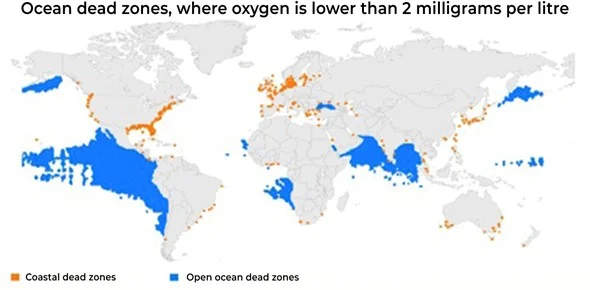Answer:
| Approach:
Introduction
Body
- Discuss the Significance of dead zones on marine ecosystems.
Conclusion
- Conclude your answer with a significant threat to the marine ecosystem with a futuristic approach.
|
Introduction:
A Dead Zone is an area of the ocean with low or no oxygen levels, where marine life cannot survive. The main cause of Dead Zones is eutrophication, the process by which excessive nutrients, such as nitrogen and phosphorus, enter coastal waters from agricultural and industrial sources, causing an overgrowth of algae. When these algae die, they sink to the bottom and decompose, depleting the oxygen in the water.
Enroll now for UPSC Online Course
Body:
Consequences of Dead Zones on marine ecosystems:
- Loss of Marine Life: Dead Zones can cause significant losses of marine life, as oxygen-deprived fish, crabs, and other organisms suffocate and die. These organisms are crucial to the food chain, and their loss can have cascading effects throughout the ecosystem.
- Changes in Food Web: Dead Zones can cause changes in the marine food web, as the loss of oxygen-loving organisms allows other, more resilient species to thrive. This can alter the balance of the ecosystem, leading to unpredictable and potentially damaging changes.
- Economic Impacts: Dead Zones can have significant economic impacts, as they can lead to reduced fish catches and lost revenue for fishing communities. They can also harm the tourism industry, as people are less likely to visit areas with poor water quality.
- Climate Change: Dead Zones can contribute to climate change, as the decomposition of organic matter in these areas releases large amounts of carbon dioxide and other greenhouse gasses into the atmosphere.
- Human Health: Dead Zones can also pose a risk to human health, as they can lead to the proliferation of harmful bacteria and toxins, which can contaminate seafood and pose a risk to human health.
Some examples of dead zones:

- Gulf of Mexico Dead Zone
- Baltic Sea Dead Zone
- Chesapeake Bay Dead Zone
- Black Sea Dead Zone
- Lake Erie Dead Zone
Conclusion:
The spreading of ‘Dead Zones’ poses a significant threat to the marine ecosystem. It can lead to a decline in fish populations, an increase in harmful algal blooms, and a shift in the species composition. We can take measures to reduce nutrient pollution and protect our oceans from these growing environmental issues.
